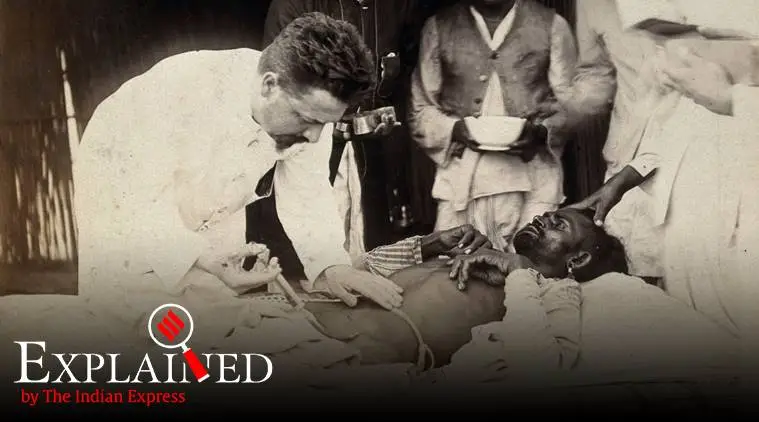Shyamlal Yadav is one of the pioneers of the effective use of RTI for investigative reporting. He is a member of the Investigative Team. His reporting on polluted rivers, foreign travel of public servants, MPs appointing relatives as assistants, fake journals, LIC’s lapsed policies, Honorary doctorates conferred to politicians and officials, Bank officials putting their own money into Jan Dhan accounts and more has made a huge impact. He is member of the International Consortium of Investigative Journalists (ICIJ). He has been part of global investigations like Paradise Papers, Fincen Files, Pandora Papers, Uber Files and Hidden Treasures. After his investigation in March 2023 the Metropolitan Museum of Art, New York returned 16 antiquities to India. Besides investigative work, he keeps writing on social and political issues. ... Read More
Explained: 123 years ago, when bubonic plague led to country’s Epidemic Diseases Act
How did the Act come to be? From 123-year-old proceedings of the Council of the Governor General of India, accessed by The Indian Express, a look at the circumstances and the debate on the legislation.
 A doctor administers an injection to a patient during an outbreak of bubonic plague. (Source: Wikimedia Commons)
A doctor administers an injection to a patient during an outbreak of bubonic plague. (Source: Wikimedia Commons)
Last month, the Centre amended the Epidemic Disease Act, 1897, making attacks on healthcare workers a cognisable, non-bailable offence. It had invoked the Act in March itself to fight the Covid-19 outbreak. The colonial-era Act empowers the state governments to take special measures and prescribe regulations in an epidemic, defines penalties for disobedience of these regulations, and provides for immunity for actions taken under the Act “in good faith”.
How did the Act come to be? From 123-year-old proceedings of the Council of the Governor General of India, accessed by The Indian Express, a look at the circumstances and the debate on the legislation.
Why the need was felt
Council member J Woodburn tabled the Epidemic Diseases Bill on January 28, 1897, during an outbreak of bubonic plague. “Plague which has taken root in Bombay has been gradually extending to other parts of the country, and it seems to the Government expedient that some measures should be promptly taken before the disease has attained large proportions elsewhere to hold it in check,” Woodburn said. The Bill noted that municipal bodies, cantonments and other local governments had extraordinary powers to deal with such situations but felt those were “inadequate.” The government of the day was also concerned that several countries were alarmed by the situation in India, and Russia had speculated that the whole subcontinent might be infected. The Bill called for special powers for governments of Indian provinces and local bodies, including to check passengers of trains and sea routes. It said existing laws were insufficient to enable municipal officers to deal with various matters such as “overcrowded houses, neglected latrines and huts, accumulations of filth, insanitary cowsheds and stables, and the disposal of house refuse.”
How it was passed
The Bill was referred to a Select Committee headed by James Westland. The Committee submitted its report the very next week, on February 4, 1897, and the Bill was passed the same day, after a brief discussion.
The Bill was passed amid concerns of the disease spreading, with crowds from Bombay having reached places all over India. The government was particularly worried about Calcutta, then the Indian capital.
Among members who spoke, Rahimtula Muhammad Sayani and Maharaja of Darbhanga Lakshmishwar Singh said the Bill was being tabled and passed hurriedly. Yet the Maharaja of Darbhanga also described the situation as “one of the most dreadful scourges that have ever afflicted the human race”.
Woodburn himself observed, “I received a memorandum from the Editor (name not mentioned) of an intelligent and interesting native newspaper complaining that the Bill was being passed too hurriedly and conveyed no explanation of the Regulations that were to be made under the Bill.”
Challenges discussed
Babu Joy Gobind Law suggested that steps be taken with regard to pilgrimage to Mecca. “I need hardly say that pilgrimage is a great danger and requires drastic remedies.”
Alexander Mackenzie, Lieutenant Governor of Bengal, said he was surprised that no Muslim members had touched that issue, but clarified that his government was “unwilling to interfere with religious practices and prejudice”. Sayani stood up and said, “The reasonable thing to do is that the persons desirous of performing the pilgrimage might be persuaded to put off their intention till the danger has passed.”
📢 Express Explained is now on Telegram. Click here to join our channel (@ieexplained) and stay updated with the latest
It was discussed that isolating women was particularly difficult. When Woodburn was told that “many of the (Indians) would rather die of the plague than allow themselves to be segregated or removed”, he said, “We could not allow the whole town to run the risk of plague infection merely because the source of that infection happened to be a woman”.
What has changed
Through an ordinance on April 22, the Cabinet amended the Act to say that commission or abetment of acts of violence against healthcare service personnel shall be punished with imprisonment for a term of three months to five years, and with fine of Rs 50,000 to Rs 2 lakh. In case of causing grievous hurt, imprisonment shall be for a term of six months to seven years and with fine of Rs1 lakh to Rs 5 lakh.
Photos





- 01
- 02
- 03
- 04
- 05


































